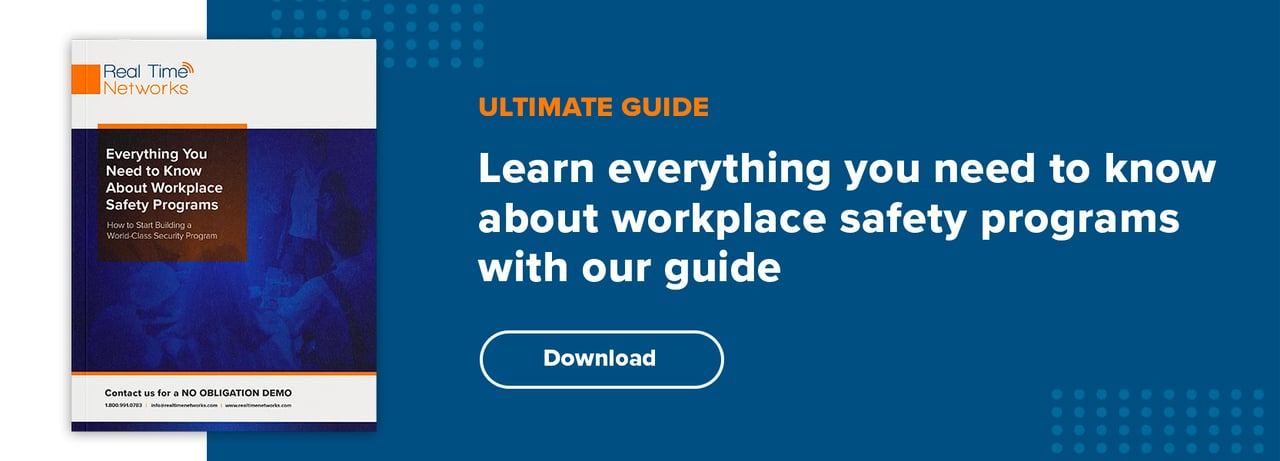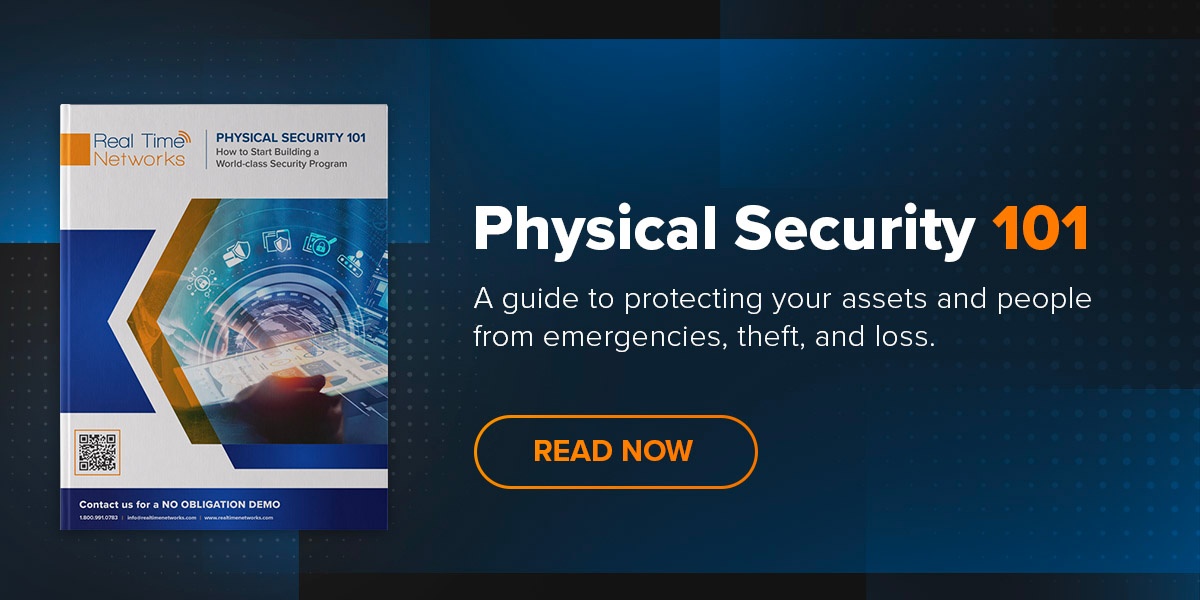Employee location tracking isn’t some evil, Big Brother tool. In fact, in most use cases, the employees benefit as much as their organization. That’s because the most effective use cases are all for employee safety and security.
Many different types of tracking tools are on the market. But indoor positioning systems (IPSs) are among the most popular choices for employee location tracking in a building.
Are you wondering whether tracking employee locations might be the right solution to a security challenge you’re having? This article will tell you everything you need to know about how an IPS works, how they’re commonly used, and some of the best practices you should follow to get the most out of any IPS you purchase.
What is indoor positioning?
An indoor positioning system is the indoor equivalent of GPS. An IPS provides human operators with information on all tracked assets’ locations and movement histories.
An IPS consists of a network of wireless sensors—sometimes called tags or transmitters—and receivers controlled and monitored by a central management system. Several different wireless technologies are commonly used for tags and receivers to communicate.
The sensors send location data, transaction data, and other information back to the central management system. The management system can perform many automated tasks, such as alerting security officers should an employee enter a restricted area. It can also generate reports that can be used for compliance efforts and to identify performance trends that might only reveal themselves in large data sets collected over time.
What is an employee tracking system?
An employee tracking system identifies the location of individuals as they move through an indoor facility. Some systems can provide real-time tracking anywhere in the covered area. Other systems only read locations as personnel approach checkpoints, entryways, or exits, a process called “presence-based” tracking.
You can also use an employee tracking system in your building to create virtual perimeters, so-called “geofences.” These are boundaries defined within the tracking software. Geofences can be helpful in open facilities where you need insights on employee movements without setting physical barriers.
Can employers track your location?
If you’re wearing or carrying a tag, yes, they can when you’re within range of an IPS receiver. But it’s important to remember that these systems aren’t designed to be punitive. IPS tracking systems can help keep employees accountable for their actions, but they’re most effective as tools for protecting employees.
What is indoor asset tracking?
Similar to employee tracking, you can also tag and track valuable equipment. You can mount asset tags to assets you wish to track or sometimes even insert them directly into critical assets. Real-time and presence-based tracking are both options here as well.
Why track employees?
Organizations that adopt employee tracking systems in their buildings usually want to do one or more of these things:
1. Improve safety.
You can use a tracking system to monitor an employee when they’re working alone or in a high-risk setting. You can also use tracking systems to help manage emergency response efforts and evacuations.
2. Manage more effectively.
IPS software allows you to manage performance and employee safety easily. Modern software is designed to work across various devices, including PCs, tablets, and smartphones. You can pull up your tracking dashboard anywhere—no more digging through week-old paper logs to find out when an employee last entered a restricted area.
Management software also allows you to configure triggered alerts. Remember geofenced perimeters? For example, you could configure a warning that’s sent to security should unauthorized employees cross a geofence into a restricted space.
3. Get business insights in real time.
Triggered alerts and real-time location tracking provide you with up-to-the-second intelligence on everything that happens at your worksite. You can pull up the location of key personnel in an instant. You can dig into detailed logs to see the entire movement history of visitors in your facility.
4. Respond to incidents faster.
Those up-to-the-second insights allow you to mount an incident response as fast as possible. Lone workers can trigger a safety alert when they’re in distress. Security officers can see right in the IPS dashboard where they’re located with room-level precision.
In high-security settings, supervisors can monitor the progress of security guards in real time. Should an incident occur, they can quickly identify which officers are closest and dispatch them for rapid response.
5. Eliminate human error.
Tracking employees with an IPS is not only more efficient, but it also eliminates human error. An IPS never forgets to track an employee or misenters their location. An IPS never gets tired or ends its shift. These systems are always on and always working.

What are some use cases for employee tracking systems?
Employee tracking systems have a wide range of potential use cases. Some of the most popular include:
- Guard tour monitoring: Track guard movements in real time as they tour your high-security venues, or deploy presence-based IPS checkpoints where they can easily log progress, allowing them to maintain situational awareness.
- Emergency mustering: An IPS allows you to track employees as they evacuate your worksite and automatically flag them safe when they reach muster points. Your emergency managers will be able to see at a glance who is safe and who is still at risk in your facility, which makes it faster and simpler for them to coordinate with first responders.
- Lone worker safety: An IPS also makes it easy for lone workers and other at-risk employees to bring security personnel to them. You can issue those workers IPS tags that passively record their location until they trigger a duress alarm. The IPS instantly notifies security officers of their location.
- Visitor management: Know where every individual, including contractors, guests, temp workers, and service personnel, is located on-site. IPS visitor management keeps everyone safe in high-security or regulated environments.
- Operations monitoring: An IPS is valuable outside of emergencies too. You can use an IPS to identify worker locations in real time and dispatch them as needed for urgent service requests. An IPS makes it easy to manage mobile workforces that are always on the move in large, open, or just plain busy worksites.
What are some best practices for implementing employee location tracking in a building?
No matter which use case you’re interested in, there are some best practices you should follow during your system’s deployment and use.
Manage employee hesitancy.
Many employees are wary of tracking programs. They see these systems as overbearing, an invasion of privacy, or just unnecessary micromanagement. Before you install any new IPS, make sure you communicate your company’s goals to all of your employees. Explain how the system will make their lives easier and safer and make the organization operate more effectively.
Train everyone on the new system.
In addition to communicating with all staff up front, you also need to train everyone on the new system. Even the easiest-to-use employee tracking IPS will present a learning curve for your team. Plan to conduct initial training so your staff can effectively use the new system from day one.
Document your use policy.
Keep everyone on the same page by documenting the acceptable use you want to set for your new IPS technology. Setting clear, transparent, and universal standards for the whole organization can also help reduce employee hesitancy. It shows that the organization wants everyone to be on the same page and held accountable to the same standards.
Integrate with your other security technology.
You can gain some valuable operating efficiencies if you’re able to integrate your employee tracking system with other security systems, such as your access control and asset management platforms. Most commonly, you streamline user management by keeping all security-related accounts in one integrated management hub.
Fit employee tracking into your overall safety program.
Employee tracking in a building will only be so valuable in isolation. Much like how you want to integrate technology, employee tracking needs to be an integrated part of your overall safety and security program. Adapt your security practices, evacuation routes, and visitor management policies according to the new capabilities your IPS will offer.
Audit and optimize performance.
Indoor positioning is still an emerging technical field. New best practices and technical updates for employee tracking systems will regularly become available in the future.
Schedule periodic reviews of your current program to see what you can add or optimize to make your tracking more effective. You can analyze reports from your management dashboard to inform this decision-making.
Work with your IPS service provider to determine what changes make sense for your organization. Because indoor positioning is an evolving field, it’s essential to find a reliable service provider with whom you can establish a long-term business relationship.
Strengthen your safety and security program with employee location tracking.
Monitoring the flow of visitors, employees, contractors, and anyone else in your facility will improve your organization’s safety and security. An IPS can be a cost-effective solution for protecting both your people and your business. It’s a win-win.
Want to learn more about adding employee location tracking to your security program? Check out our guide, Physical Security 101: How to Start Building a World-Class Security Program.
Subscribe to our blog

Jay Palter
Vice President of Marketing & Partnerships





